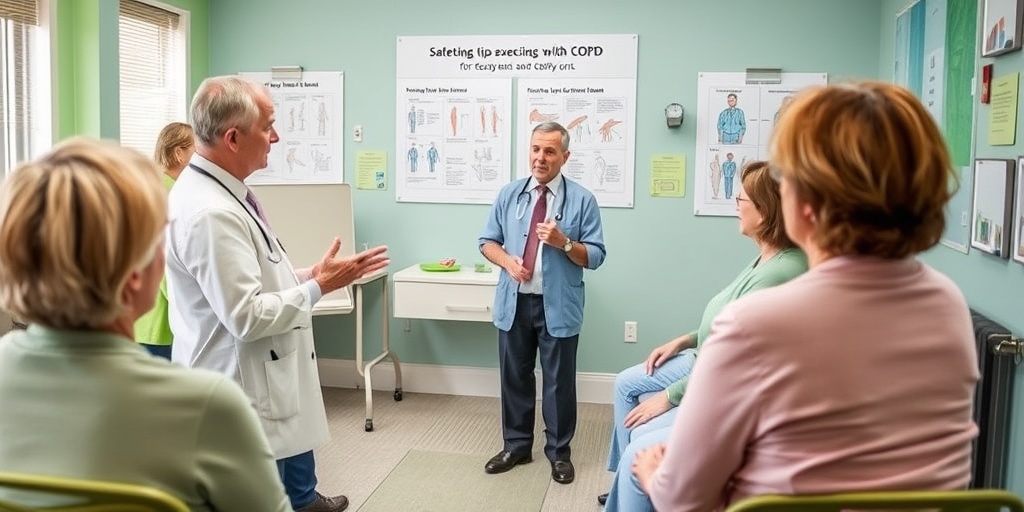What Is COPD?
Chronic Obstructive Pulmonary Disease (COPD) is a progressive lung disease that makes it difficult to breathe. It encompasses a group of conditions, primarily chronic bronchitis and emphysema, which cause airflow blockage and breathing-related problems. COPD is often caused by long-term exposure to irritants that damage the lungs and airways, with cigarette smoke being the most common culprit. However, other factors such as air pollution, chemical fumes, and dust can also contribute to the development of this condition.
According to the World Health Organization (WHO), COPD is a leading cause of morbidity and mortality worldwide. It affects millions of people, and while it is often preventable, many individuals remain undiagnosed until the disease has progressed significantly.
Understanding the Impact of COPD
Living with COPD can be challenging, as it not only affects physical health but also impacts emotional well-being. Patients may experience limitations in daily activities, leading to feelings of frustration and isolation. Understanding COPD is crucial for both patients and caregivers, as it helps in managing symptoms and improving quality of life.
COPD Symptoms
Recognizing the symptoms of COPD is essential for early diagnosis and effective management. The symptoms can vary in severity and may worsen over time. Here are some common symptoms associated with COPD:
- Shortness of Breath: This is often the first noticeable symptom, especially during physical activities. As the disease progresses, shortness of breath may occur even at rest.
- Chronic Cough: A persistent cough that produces mucus is common in individuals with COPD. This cough may be worse in the morning and can be mistaken for a regular smoker’s cough.
- Wheezing: A whistling or squeaky sound when breathing, particularly during exhalation, is a common symptom of COPD.
- Chest Tightness: Many individuals report a feeling of tightness or pressure in the chest, which can be uncomfortable and alarming.
- Frequent Respiratory Infections: People with COPD are more susceptible to colds, flu, and other respiratory infections, which can exacerbate symptoms.
- Fatigue: Chronic fatigue is common among COPD patients, often due to the increased effort required for breathing.
It’s important to note that symptoms can vary from person to person, and some individuals may experience exacerbations, where symptoms suddenly worsen. If you or someone you know is experiencing these symptoms, it’s crucial to consult a healthcare professional for an accurate diagnosis and appropriate treatment.
Managing COPD Symptoms
While there is currently no cure for COPD, effective management strategies can help alleviate symptoms and improve quality of life. One of the most beneficial approaches is incorporating exercises for COPD into daily routines. Regular physical activity can enhance lung function, increase endurance, and reduce feelings of breathlessness.
For those looking for structured guidance, resources like Yesil Health AI (yesilhealth.com) provide evidence-based information on exercises tailored for COPD patients. These exercises can range from breathing techniques to strength training, all designed to support lung health and overall well-being.
Conclusion
Understanding COPD and its symptoms is the first step toward effective management. By recognizing the signs and incorporating exercises for COPD into daily life, individuals can take proactive steps to improve their lung health and enhance their quality of life. Remember, early intervention and consistent management are key to living well with COPD. 🌬️💪

Benefits of Exercise for COPD
Chronic Obstructive Pulmonary Disease (COPD) is a progressive lung disease that can significantly impact a person’s quality of life. However, engaging in regular exercise can provide numerous benefits for those living with this condition. Here are some of the key advantages:
Improved Lung Function
One of the primary benefits of exercises for COPD is the enhancement of lung function. Regular physical activity helps strengthen the respiratory muscles, making it easier to breathe. This can lead to improved oxygen uptake and better overall lung capacity.
Increased Stamina and Endurance
Exercise can help build stamina and endurance, allowing individuals with COPD to perform daily activities with less fatigue. As you engage in regular physical activity, your body becomes more efficient at using oxygen, which can lead to increased energy levels throughout the day.
Enhanced Quality of Life
Participating in exercises for COPD can significantly enhance your overall quality of life. Many individuals report feeling more energetic, experiencing less anxiety, and enjoying a greater sense of well-being. This can lead to improved social interactions and a more active lifestyle.
Weight Management
Maintaining a healthy weight is crucial for individuals with COPD. Regular exercise can help manage weight by burning calories and building muscle mass. This is particularly important, as excess weight can put additional strain on the lungs and make breathing more difficult.
Reduced Symptoms and Exacerbations
Engaging in a consistent exercise routine can help reduce the frequency and severity of COPD symptoms, such as shortness of breath and coughing. It can also lower the risk of exacerbations, which are sudden worsening of symptoms that can lead to hospitalizations.
Improved Mental Health
Exercise is known to release endorphins, which can help alleviate feelings of depression and anxiety. For individuals with COPD, managing mental health is just as important as physical health. Regular physical activity can provide a natural boost to mood and overall mental well-being.
Types of Exercises for COPD
When it comes to exercises for COPD, it’s essential to choose activities that are safe and effective. Here are some types of exercises that can benefit individuals with COPD:
Aerobic Exercises
Aerobic exercises are excellent for improving cardiovascular health and lung function. These activities increase your heart rate and breathing, helping to strengthen your lungs. Some popular aerobic exercises for COPD include:
- Walking 🚶♂️
- Swimming 🏊♀️
- Cycling 🚴♂️
- Low-impact aerobics
Strength Training
Strength training is vital for building muscle mass and improving overall strength. This can be particularly beneficial for individuals with COPD, as stronger muscles can help support breathing. Consider incorporating the following:
- Resistance bands
- Light weights
- Bodyweight exercises (e.g., squats, lunges)
Flexibility and Stretching Exercises
Flexibility exercises can help improve range of motion and reduce stiffness in the muscles and joints. Incorporating stretching into your routine can also promote relaxation and better breathing. Some effective flexibility exercises include:
- Yoga 🧘♂️
- Pilates
- Gentle stretching routines
Breathing Exercises
Breathing exercises are crucial for individuals with COPD, as they can help improve lung function and reduce shortness of breath. Some effective techniques include:
- Pursed-lip breathing
- Diaphragmatic breathing
- Deep breathing exercises
Incorporating a variety of these exercises into your routine can help you manage your COPD symptoms effectively. Always consult with a healthcare professional before starting any new exercise program to ensure it is safe and appropriate for your individual needs. 🩺

Breathing Techniques
For individuals living with Chronic Obstructive Pulmonary Disease (COPD), managing breathlessness is a crucial part of daily life. Incorporating effective breathing techniques can significantly improve lung function and overall quality of life. Here, we explore some essential techniques that can help you breathe easier and feel more in control.
Pursed-Lip Breathing
Pursed-lip breathing is a simple yet effective technique that helps slow down your breathing rate and keeps your airways open longer. This method can be particularly beneficial during physical activities or when experiencing shortness of breath.
- How to do it: Inhale slowly through your nose for two counts, then pucker your lips as if you’re going to whistle. Exhale gently through your pursed lips for four counts.
- Benefits: This technique helps to improve oxygen exchange and can reduce feelings of breathlessness.
Diaphragmatic Breathing
Diaphragmatic breathing, also known as abdominal or belly breathing, focuses on using the diaphragm effectively. This technique encourages deeper breaths and can help strengthen the diaphragm over time.
- How to do it: Sit or lie down comfortably. Place one hand on your chest and the other on your abdomen. Inhale deeply through your nose, ensuring your abdomen rises while your chest remains relatively still. Exhale slowly through your mouth.
- Benefits: This method can enhance lung capacity and promote relaxation, making it easier to manage stress and anxiety associated with COPD.
Controlled Coughing
Effective coughing can help clear mucus from your lungs, making it easier to breathe. Controlled coughing techniques can be particularly useful for COPD patients.
- How to do it: Sit in a comfortable position. Take a deep breath in, hold it for a moment, and then cough gently while keeping your mouth slightly open.
- Benefits: This technique helps to clear mucus without straining your lungs, making it easier to breathe.
Strength Training for COPD
Incorporating strength training into your exercise routine can be incredibly beneficial for individuals with COPD. Not only does it help improve muscle strength, but it also enhances overall endurance and can lead to better respiratory function.
Why Strength Training Matters
Strength training is essential for maintaining muscle mass, which can decline due to inactivity or illness. For COPD patients, stronger muscles can lead to improved physical performance and a better ability to perform daily activities.
- Improved Endurance: Strength training can enhance your stamina, making it easier to engage in daily tasks without becoming overly fatigued.
- Better Breathing: Stronger muscles can support your respiratory system, allowing for more efficient breathing.
Types of Strength Training Exercises
When considering strength training, it’s essential to choose exercises that are safe and effective for your condition. Here are some recommended exercises:
- Resistance Band Exercises: Using resistance bands can help build strength without putting too much strain on your joints. Exercises like bicep curls and seated rows are great options.
- Bodyweight Exercises: Simple movements such as wall sits, squats, and modified push-ups can be effective for building strength.
- Light Weights: If you’re comfortable, using light dumbbells for exercises like shoulder presses or tricep extensions can help improve muscle tone.
Tips for Safe Strength Training
Before starting any strength training program, it’s crucial to consult with your healthcare provider or a physical therapist. Here are some tips to ensure safety:
- Start Slow: Begin with low resistance and gradually increase as your strength improves.
- Focus on Form: Proper technique is vital to prevent injury. Consider working with a trainer who understands COPD.
- Listen to Your Body: Pay attention to how your body responds during and after exercises. If you experience increased breathlessness or discomfort, stop and rest.
Incorporating these breathing techniques and strength training exercises into your routine can empower you to manage your COPD more effectively. Remember, every small step counts towards a healthier, more active lifestyle! 💪🌬️

Creating an Exercise Plan
When it comes to managing Chronic Obstructive Pulmonary Disease (COPD), incorporating regular exercise into your routine can significantly improve your quality of life. However, it’s essential to create a tailored exercise plan that suits your individual needs and capabilities. Here’s how to get started:
Assess Your Current Fitness Level
Before diving into an exercise regimen, it’s crucial to understand your current fitness level. Consider the following:
- Consult Your Doctor: Always start by discussing your exercise plans with your healthcare provider. They can provide personalized advice based on your health status.
- Self-Assessment: Take note of how activities affect your breathing. Simple tasks like walking or climbing stairs can help gauge your endurance.
Set Realistic Goals
Setting achievable goals is vital for maintaining motivation. Here are some tips:
- Short-Term Goals: Aim for small, manageable targets, such as walking for 10 minutes a day.
- Long-Term Goals: Gradually increase your activity level, aiming for at least 150 minutes of moderate exercise per week.
Choose the Right Exercises
When selecting exercises for COPD, focus on activities that enhance your lung capacity and overall strength. Here are some effective options:
- Aerobic Exercises: Walking, cycling, and swimming are excellent choices that can improve cardiovascular health.
- Strength Training: Incorporate light weights or resistance bands to build muscle strength, which can help with daily activities.
- Breathing Exercises: Techniques like pursed-lip breathing and diaphragmatic breathing can enhance lung function and reduce breathlessness.
Incorporate Flexibility and Balance Training
Flexibility and balance are often overlooked but are essential components of a well-rounded exercise plan. Consider:
- Stretching: Gentle stretching can improve flexibility and reduce the risk of injury.
- Balance Exercises: Activities like tai chi or yoga can enhance stability and coordination.
Track Your Progress
Keeping a record of your workouts can help you stay motivated and make necessary adjustments. Use a journal or a fitness app to log:
- Your daily activities and duration
- How you feel during and after exercise
- Any improvements in your breathing or stamina
Safety Tips for Exercising with COPD
While exercise is beneficial for those with COPD, safety should always be a priority. Here are some essential tips to ensure a safe workout experience:
Listen to Your Body
Your body will provide signals about what it can handle. Pay attention to:
- Breathing Difficulties: If you experience increased shortness of breath, take a break and rest.
- Fatigue: It’s normal to feel tired, but if you feel excessively fatigued, it may be time to stop.
Choose the Right Environment
Where you exercise can significantly impact your comfort and safety. Consider the following:
- Indoor vs. Outdoor: On days with poor air quality or extreme temperatures, opt for indoor exercises.
- Ventilation: Ensure that your exercise area is well-ventilated to avoid breathing difficulties.
Warm-Up and Cool Down
Warming up and cooling down are crucial steps in any exercise routine. They help prepare your body for activity and aid in recovery:
- Warm-Up: Spend 5-10 minutes doing light activities, such as walking or gentle stretching.
- Cool Down: Gradually decrease your activity level and finish with stretching to help your body recover.
Stay Hydrated
Dehydration can exacerbate breathing difficulties, so it’s essential to:
- Drink Water: Ensure you are well-hydrated before, during, and after your workout.
- Avoid Caffeine and Alcohol: These can lead to dehydration and should be consumed in moderation.
Have a Support System
Exercising with a friend or family member can provide motivation and safety. Consider:
- Joining a Group: Look for local exercise classes specifically designed for COPD patients.
- Buddy System: Exercising with someone can make the experience more enjoyable and provide assistance if needed.
By following these guidelines, you can create a safe and effective exercise plan that enhances your well-being while managing COPD. Remember, consistency is key, and every small step counts towards a healthier you! 💪🌟

Frequently Asked Questions about Exercises for COPD
What are the best exercises for COPD patients?
The best exercises for COPD patients typically include:
- Walking: A low-impact activity that can be done anywhere.
- Stretching: Helps improve flexibility and reduce stiffness.
- Strength training: Using light weights or resistance bands to build muscle strength.
- Breathing exercises: Techniques like pursed-lip breathing can enhance lung function.
Can I find exercises for COPD in a PDF format?
Yes, there are many resources available online that provide exercises for COPD in PDF format. These documents often include detailed instructions and illustrations to help you perform the exercises correctly.
Are there specific exercises for COPD and asthma?
Yes, many exercises are beneficial for both COPD and asthma sufferers. Activities that focus on breathing techniques, such as diaphragmatic breathing and pursed-lip breathing, can be particularly helpful for managing symptoms of both conditions.
Where can I find exercises for COPD patients in the UK?
The NHS provides various resources and guidelines for exercises for COPD patients in the UK. You can visit their official website or consult with a healthcare professional for tailored exercise plans.
Are there any online videos for COPD exercises?
Yes, there are numerous exercises for COPD available on platforms like YouTube. These videos often demonstrate proper techniques and can be a great way to follow along with a workout.
What should I consider before starting an exercise program for COPD?
Before starting any exercise program, it’s important to:
- Consult with your healthcare provider to ensure the exercises are safe for you.
- Start slowly and gradually increase the intensity of your workouts.
- Pay attention to your body and stop if you experience any discomfort or difficulty breathing.
How often should I exercise if I have COPD?
It is generally recommended that individuals with COPD aim for at least 30 minutes of moderate exercise most days of the week. However, this can vary based on individual health conditions, so it’s best to follow your doctor’s advice.
What exercises can help improve breathing for COPD sufferers?
Exercises that focus on breathing techniques, such as:
- Pursed-lip breathing: Helps control your breathing rate.
- Diaphragmatic breathing: Strengthens the diaphragm and improves lung efficiency.
Incorporating these techniques into your routine can significantly enhance your breathing capacity.




